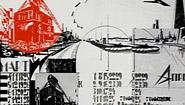News from Ideological Antiquity
News from Ideological Antiquity
First Version, 2008
On October 12, 1927, Sergei Eisenstein finished production on October. How could he possibly continue working after that colossal film? He writes in his notes: “I have decided to adapt CAPITAL based on K. Marx’s scenario.” But how could one ‘cinematize’ (Eisenstein) money, commodity, profit, and capital, when what is at stake is not content, but the abstract forms of all manner of things, human beings, and relationships? That is why Eisenstein, over the course of his project, would not allow himself to film the stock exchange. What is there to see there, without simultaneously filming the famines caused by commodity future transactions, the poverty, the child labor, and the global drug trade? It would only present the glamour of a beautifully organized administration that capital itself wants to believe in. To film the stock exchange means to represent the ideology (the false consciousness) of capital, not its reality.
Eisenstein was preoccupied with the question of how to capture capital on screen. His notes for the Capital project – accessible only in recent years – also allow us to discover a director completely different from the maker of Battleship Potemkin. Eisenstein positions his Capital project as a wholly new kind of film, set off from the previous history of cinema, which he calls ‘ancient cinema.’ Where ‘ancient cinema’ has a linear narrative, he wants to develop a ‘spherical dramaturgy’: “In ancient film, a plot was told from different perspectives. New cinema uses montage to develop one perspective from several plots.” For Eisenstein, this perspective was presumably capital itself. Multiple plots, assembled in constellation, in relationship and in opposition to each other, were supposed to reflect on the central theme of capital, which is abstract and indifferent toward substance.


